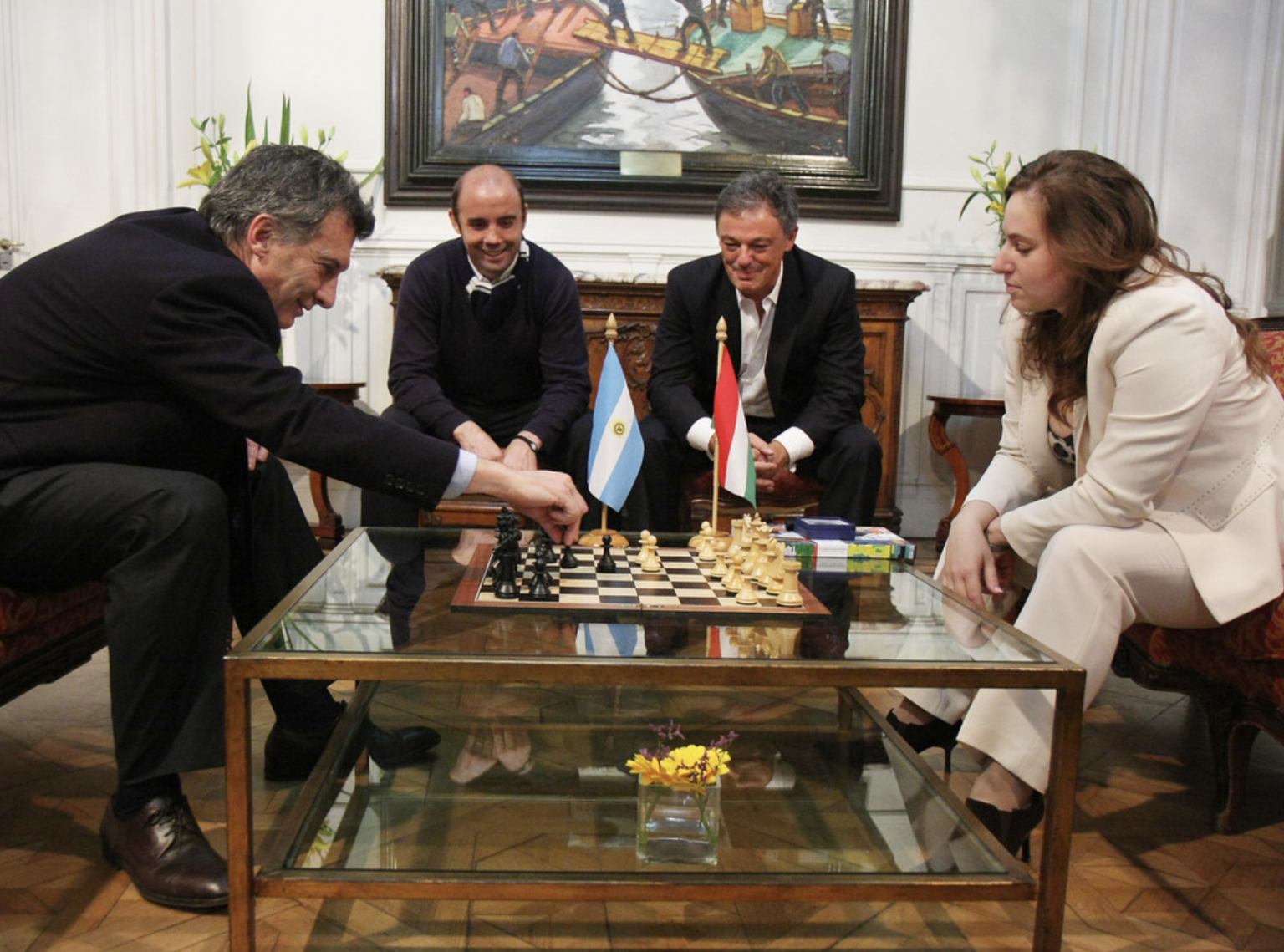
The owner of this interactive NFT will get to play the real life “Queen’s Gambit,” but do they dare?
Gender segregation in sports is the norm, and in some cases it’s actually part of the rules. Male and female athletes play in parallel worlds that rarely intersect. When it comes to chess, where the game requires no physical skill and players rely only on the strength of their minds, the insistence on segregation raises some serious questions about how we perceive gender equality once it’s stripped of biological arguments. Can two players be equal in skill if they’re never matched?

“Mauricio Macri con Judit Polgar (1 de 4)” by Mauricio Macri, licensed under CC BY-ND 2.0
In 2002 at the 3rd Russia vs Rest of the World Match, 24-year-old chess prodigy and real-life “Queen’s Gambit,” Judit Polgár defeated World Chess Champion Garry Kasparov. This was the first time in the history of any sport that the top-ranked woman in the world went up against the top-ranked male player and defeated him.
“Queen of Chess: Polgár beats Kasparov”
View the 3D interactive 1/1 artwork here.
This was no matter of luck; by the age of 5, Polgár was winning against highly skilled adult chess players. By the age of 15, she received the title of Grandmaster. She was the youngest person at the time to receive that title, the highest rank a player can earn. Her opponent, Kasparov, was arguably the greatest Chess player in the world, and had been quoted in the 1989 November issue of Playboy saying: “Some people don’t like to hear this, but chess does not fit women properly. It’s a fight, you know? A big fight. It’s not for women.” It’s not difficult to imagine what he must have sounded like off the record, but sexist comments aside, it takes an extremely skilled player to enter any boys’ club. Women are statistically discouraged to pursue certain paths from a young age. It takes an even more powerful player to meet an opponent as an equal, despite voices like Kasparov’s who argued that equality is inherently impossible.
“It means a lot to me that my historic game against Kasparov where I won got to be minted into an NFT. Creativity is a lifestyle, art is air for the soul, and innovation is the future. It was a special journey to relive my victory and create my first NFT with Laszlo Barabási and his team.”
— JUDIT POLGÁR
It’s been nearly twenty years since the historic match took place in September of 2002. To commemorate her victory and the important advances women players in chess have made since then, Judit Polgár released her first NFT on SuperRare in collaboration with her friend, acclaimed network scientist and fellow pioneer Albert-László Barabasi and his team at BarabásiLab. One of the most influential labs in network science, BarabásiLab brings together scientists, artists, and designers for boundary-bending collaborations. The NFT is titled “Queen of Chess: Polgár Beats Kasparov” and it replays the historic game as a 3D interactive video, allowing the viewer to flip the board and play the game from either player’s perspective. Polgár’s white pieces and Kasparov’s black pieces move on opposite sides of the chessboard, reminding viewers that for decades women and men were rarely granted the opportunity to play on the same board.


“We approached the journey with Judit with a desire to take full advantage of the capabilities offered by crypto art: to express the deep transformation that her victory brought to the acceptance of women champions. This is why we turned the historic game into a kinetic sculpture, one that offers interactivity, and allows you to follow the game from both Judit’s and Kasparov’s perspectives. I see Judit as the real-life Beth Harmon of “The Queen’s Gambit,” and the work had to match her achievement in both gravitas and elegance.”
— LASZLO BARABASI
This collaborative work will be on auction through December 16th. The highest bidder will also win a rare opportunity to play Polgár herself in a private match. Proceeds from the sale will be donated to the Judit Polgár Chess Foundation whose mission is to invest in educational benefits of chess in children as a way to boost creativity and expertise.
“I established the Judit Polgar Chess Foundation in 2012 when I was still playing competitively. The experience and feedback reveal Chess has a place in education and can make a difference for the next generation, empowering them with better critical-thinking skills.”
— JUDIT POLGÁR


Images from juditpolgar.com
This NFT is an especially exciting collaboration, a meeting between the two great minds of Polgár and Barabási. The recent recipient of the European Physical Society’s Statistical and Nonlinear Physics Prize, Barabási is the author of several books which have been translated to over twenty languages, amongst them Network Science (Cambridge, 2016). Originally intending to become a sculptor, he ended up pursuing an impressive career as a scientist, unveiling hidden complex systems using quantitative tools of network science, a field he pioneered. Barabási finds himself re-entering the realm of art with a unique perspective that pushes the boundaries of interactivity in digital realms in data art and beyond. Working together with his team, Casa Both, Milan Janoso, and Kishore Vasan, Barabási creates works that synthesize science and art, much like the fusion of creativity and logic that makes chess a timeless and impelling game. Although we’ve come a long way since 2002, only a small percentage of top world chess players are women. This unique NFT is a reminder that it takes fearless pioneers like Polgár to challenge not only the world’s top players, but the very patriarchy that segregates the game.
Art

Curated Conversations: ALIENQUEEN
SuperRare Labs Senior Curator An interviews ALIENQUEEN about psychedelics, death, and her journey in the NFT space.
Tech


Out of the Vault and onto the Chain: the Evolving Nature of Provenance
SuperRare editor Oli Scialdone considers the social experience of provenance and its relationship with community in the Web3 space.
Curators' Choice



Curated Conversations: ALIENQUEEN
SuperRare Labs Senior Curator An interviews ALIENQUEEN about psychedelics, death, and her journey in the NFT space.


